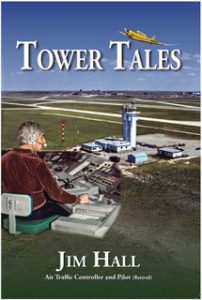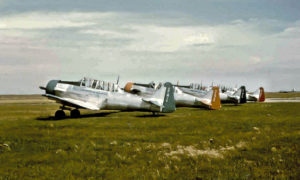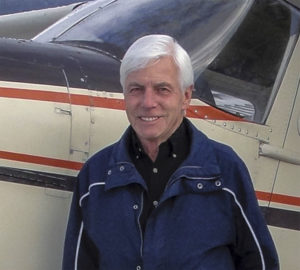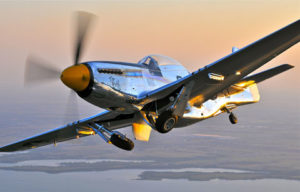My 7 years in a Harvard. 1961 – 1968 – Story by “Jim Hall”
 Tower Tales – This is an excerpt from one of the chapters of my book on occurrences, accidents and fatal crashes while I was on duty in ATC over a 27 year period and stories I experienced during my 50+ years flying with a CPL. (Jim Hall – See bottom of the page for details on where to purchase the book)
Tower Tales – This is an excerpt from one of the chapters of my book on occurrences, accidents and fatal crashes while I was on duty in ATC over a 27 year period and stories I experienced during my 50+ years flying with a CPL. (Jim Hall – See bottom of the page for details on where to purchase the book)
Available – Tower Tales is now available on Amazon.ca
Tower tales
 In 1961 Chinook Flying Service in Calgary was awarded the Hail Suppression contract. Four Harvard Mk 2’s were purchased from the RCAF. This was the only aircraft at the time that would withstand the stress of flying close to Cumulonimbus clouds and the associated winds and turbulence.
In 1961 Chinook Flying Service in Calgary was awarded the Hail Suppression contract. Four Harvard Mk 2’s were purchased from the RCAF. This was the only aircraft at the time that would withstand the stress of flying close to Cumulonimbus clouds and the associated winds and turbulence.
At the time all 4 were the Harvards that had the armament and the full panel. The guns were removed and the barrel ports sealed. The bomb mounts were left intact to hold the containers that held the fuses that contained silver-iodide that we released into the atmosphere during our flight.
My first checkout flight was to the practice area to perform aerobatics. My instructor (retired RCAF) did one, then I did one. It was my first time at aerobatics so everything was sloppy and I had to repeat it until the instructor was satisfied that I could recover from an unusual attitude.
During these manoeuvres, there was one that stumped me. When I did a roll to the left with the aid of the rudder when necessary, I was able to pull out close to the heading. But when I did it to the right, by the time I was 3/4 of the way through the roll, it would pull out on a heading 90 deg short of the roll-out heading. I didn’t plan on doing controlled rolls after this so I didn’t worry too much about perfecting it.
The Hail Suppression season was approaching and they were still short pilots. No one wanted to fly these machines because they were well abused in the RCAF and now a piece of junk. So the company had to raise the flying pay to $30 / flying hour to encourage pilots to apply. That might not appear to be much pay but in the early 1960’s I was an Air Traffic Controller and to compare the pay rate, I was making $7.50 / hour in the tower. Over the years this additional income enabled me to purchase a house. I still hadn’t had much dual on takeoff and landings (1 hour of touch and go’s). I was reluctant but they sent me out before I was ready as they needed extra aircraft in the air.
My first flight was Line-Seeding. Takeoff, climb to freezing level, usually between 9500 to 10,500 ASL and level off.
Cruise power to the beginning of my patterns, then adjust speed to slightly below cruise. I would start in a line North to South between Red Deer and Calgary, then do S-turns back and forth moving easterly until just short of the Alberta / Saskatchewan border. The pattern would be, make a 180 turn and roll out on a northerly heading. After a 50 to 80 mile flight make another 180 and roll out on a southerly heading, all the time working eastbound. My first solo flight and the landing turned out well. My next flight was in one of the other Harvards that Chinook modified by taking the back seat out and adding a large fuel tank. Their instructions to me were, blow the rear tank first then switch. They said you have about 20 seconds of fuel so make the switch fast. They said if you have to ever make a forced landing in a field always make it gear up. If not you could nose over and unable to egress. That’s all I needed to hear, now I’m petrified.
I was in the air in the late morning doing Line-Seeding. Then the clouds built with CB cells all over southern Alberta.
After 4 hours we would normally be returning for fuel and they would send another Harvard out. But with the extra range I had, I was instructed to remain up there until my fuel ran short in the main tanks. Mid-afternoon after landing, my flight time was 6 hrs. 20 min. Thank heavens for the “Relief – (piss) Tube”. This was the first and only flight with the back seat tank. The reason it was curtailed … there was no oil registering in the engine oil tank after landing, so the fuel tank was removed from the rear seat. These engines were so clapped out, in a normal 4-hour flight, they took 5 gallons of oil. They threw it and burned it.
On most Hail-Suppression flights when it was time to return to the airport, the crosswind gusts were up to 50 mph due to the passing CB’s. Every landing was a chore. Both my feet were going on the rudders and if that didn’t level a wing it was full aileron. During the flight and on taxi, if it was raining, which was most of the time, you got wet inside. The canopy insulation was no longer due to wear and age. I enjoyed doing 3 point stall landings but landing in extreme weather conditions I was more comfortable with wheel landings. I made sure I got the tailwheel on the ground ASAP so that I had immediate tailwheel steering.
By now I was getting quite pleased with myself for what I determined as being proficient on the Harvard. One little incident changed my complete opinion of who’s the boss and to keep flying the aeroplane. I recall returning one day and was landing on runway 07 which was very close to the tower. On landing, I was going to grease it on 3 pointers and show off to my working buddies in the tower.
After crossing the threshold I started to bring the nose up and slowly I reached the touchdown attitude. Three wheels, it was going to be a beauty. Little did I know I was still about 6 feet above the runway. The right-wing stalled went down and I touched right main and tailwheel. The aircraft was now heading about 45 degrees off the runway heading into the grass. I made doubly sure to hold the control column all the way back to keep the tailwheel locked. It was a rough ride across the grass.
I never touched the brakes, I let the aircraft come to rest on its own. I was now stopped. There, off my left and right-wing was pavement. I was sitting at rest on runway 16-34 a long ways from where I was supposed to be. I was rattled.
The tower called and said, “Are you OK”?
I said, “Yes, can I sit here for a minute and gather my senses?”
They said, “Sure, let us know when you want to taxi in.”
When I went on the afternoon shift at the Tower that day all I got was snickers from the Tower crew I relieved.
 Picture left age 81 – At age 24, that flight was a lesson in cockiness and humiliation. I spent the next couple of days re-evaluating my competency on the Harvard. There is absolutely no room for relaxing from the time you start the Harvard engines to the time you shut it down. I kept that in mind and all my future flights over the years were very enjoyable. Chinook purchased an additional 3 more Harvards in 1965, which were the MK4’s. They weren’t quite as bad shape mechanically as the previous MK2’s. I flew them all for the 7 years they had the Harvard contract. In 1968 they were asking $3000 with a spare engine for each Harvard. I have flown many singles up to and including the DHC2 and some twins up to the right seat in the BE20, but the memory of my flights in the Harvard I will take to the grave. This was one of the many adventures that I look back on and enjoy reminiscing about. Also telling my coffee buddies who I share old age with.
Picture left age 81 – At age 24, that flight was a lesson in cockiness and humiliation. I spent the next couple of days re-evaluating my competency on the Harvard. There is absolutely no room for relaxing from the time you start the Harvard engines to the time you shut it down. I kept that in mind and all my future flights over the years were very enjoyable. Chinook purchased an additional 3 more Harvards in 1965, which were the MK4’s. They weren’t quite as bad shape mechanically as the previous MK2’s. I flew them all for the 7 years they had the Harvard contract. In 1968 they were asking $3000 with a spare engine for each Harvard. I have flown many singles up to and including the DHC2 and some twins up to the right seat in the BE20, but the memory of my flights in the Harvard I will take to the grave. This was one of the many adventures that I look back on and enjoy reminiscing about. Also telling my coffee buddies who I share old age with.

These are the first of our 7 Harvards. The 4 are all Mk2’s. I don’t have photos of the 3 Mk4’s. The first photo is not a very good resolution photo. Is was taken on a consumer camera in 1959 by some guy that was an aeroplane photo nut. I didn’t realize he was there until he came up to me and said if I give him my name and phone number he would give me a copy of the pic. These are the first MK2’s that we flew for the first 4 years. I don’t have a pic of the 3 MK’4’s that were purchased for the last 3 years of operation, total 7 years before the company lost the contract. The type of aircraft they changed to in 1968 was Learjet’s and they seeded from the top side of the CB rather than the bottom where we seeded from. Higher up they were in smoother air.
By the way, they are still doing Hail Suppression and based in Red Deer Alberta and I think they fly Turboprop-Pressurized Twins now. If you enlarge the photo you will see me in the second Harvard. (Black hair – White shirt, age 24. If you look closely you can see the 4ft. rack under the left wing of Harvard #1. Each Rack under both wings of each Harvard contains 14 steel tubes that hold individual fuses. These individual fuses are ignited separately by the pilot. They burn for about 20 to 30 min. each. So there are 28 toggle switches attached to the underside of the instrument panel of each Harvard.
Short story number two
A story I will try to make shorter.
After my first year (1961) on Harvards, a guy I knew randomly and he knew me as a Tower Controller, purchased a P51 from the RCAF. He rebuilt it to a creampuff and was his pride and joy. He flew them in the RCAF and he now had a good job in civilian life.
 One day he saw me taxi in and get out of the Harvard. When I reached the hangar he called me over and asked me how long have I been flying Harvards. I told him last year. He said, look I have a job that takes up a lot of my time. I can only get around to flying my P51 once every month or two for a few minutes. Sometimes it may be up to 6 months. It needs to be flown often to keep the seals from drying out. I know and trust you, would you do me a favour and fly it every week or two for me?
One day he saw me taxi in and get out of the Harvard. When I reached the hangar he called me over and asked me how long have I been flying Harvards. I told him last year. He said, look I have a job that takes up a lot of my time. I can only get around to flying my P51 once every month or two for a few minutes. Sometimes it may be up to 6 months. It needs to be flown often to keep the seals from drying out. I know and trust you, would you do me a favour and fly it every week or two for me?All you have to do is pay for the gas. I will pay for all the other expenses. I couldn’t believe what I just heard.
I said, Jerry, I can’t fly your Mustang. It’s a bigger and faster aircraft than the Harvard, I would have a problem with it.
He said, no you wouldn’t, it’s easier to fly than the Harvard that’s why I’m asking you. I looked at him and said, Ya – sure, I don’t believe that story. He was damn near begging me so I said, Jerry, I can’t fly your Mustang. It’s your baby. If I even scratched it I would feel very bad about it. He said, no I will fix whatever damage you do. He ended up very disappointed and after a few years of his P51 sitting in the back of a hangar, he sold it.
Now I read the above article and think gezzz, maybe he was right, I could have been able to handle it???
But in those days I was 24 and couldn’t afford the price of car gas, let alone avgas, so I still would have had to say NO.
Jim Hall
Tower Tales is presently available at the following locations…
Tower Tales is now available on Amazon.ca
The Penhold RCAF military airport (now the civilian “Red Deer, AB.” airport – CYQF) was a Canadian Harvard Training Base until the mid-1960s. The City of Red Deer AB. took it over and now is the local civilian airport. The airport has an onsite Museum and is keeping the Harvard training stories alive. CLICK THIS LINK FOR MORE INFO